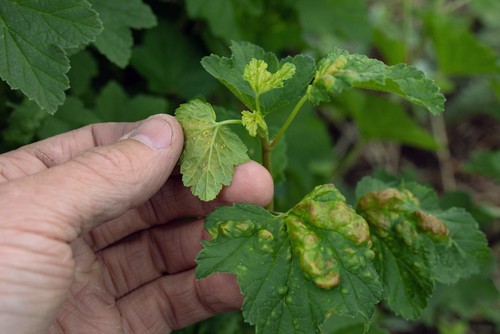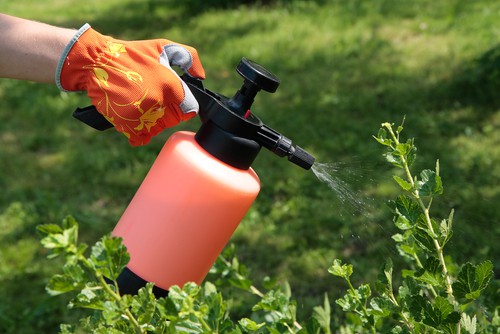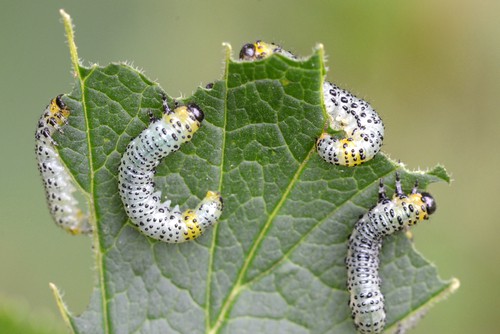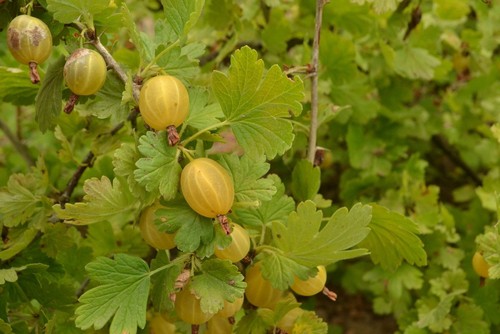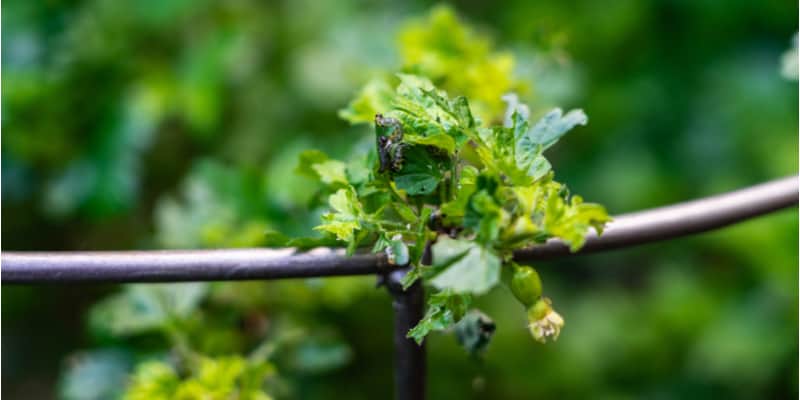
Why are my leaves curling on my gooseberries?
Our site is reader supported, this means we may earn a small commission from Amazon and other affiliates when you buy through links on our site.
Leaf curling of gooseberry leaves can either be upwards or downwards depending on a number of factors that affect your gooseberries. They could be nutritional deficiencies, disease or infection, insects, abiotic discharge, waterlogged soil, dehydration and dare I say it, even climate changes.
Insect infestation and, in particular, aphids, are usually the first culprit at the first sign of leaf curling, usually affecting the new growth at the tips of the branches. I would say 90% of the time, aphids are the cause. Aphids suck the sap from foliage that causes young leaves to curl up and crump up in a distorted manner. They usually develop in May and once they attain maturity, the adults fly away to other plants where they spend the rest of their lives for the rest of the summer. Simply uncurl the leaves to see if its aphids and if it is, spray with soapy water mix or fruit safe chemical pesticide spray available from most garden centres and nurseries.
Healthy and established plants usually have lush, green, vibrant foliage. When leaves start curling, this is a sure sign of a problem.
So what are the signs that your gooseberry leaves are under attack?
The plants may exhibit yellowing of leaves, the appearance of black spots, browning, early shading, drooping of leaves, whitish powder forming on stems and leaves, sudden loss of leaves or defoliation, just to mention a few.
We’ve already pointed out some of the reasons why the leaves on your gooseberry bush may be curling and below I provide some explanations alongside possible ways to treat the issue.
Aphids infestation
In this case, the leaves usually develop some yellow spots, and then start to wilt. Sometimes, they develop black mold that starts to grow on top of leaves. The tiny pests come in many colors like red, green, black, brown or white. They collect on the underside of leaves and sucking the sap from them, causing curling, yellowing and sometimes wilting.
Aphids also carry viruses from plant to plant and this leads to unhealthy growth in small plants. While they feed, they excrete a honeydew, a substance that makes black sooty mold growth while also attracting ants and other insects. So if you see any on your gooseberries, this is also a sign of aphids.
How to treat
One of the ways you can manage and control an aphid infestation is by spraying the aphids with potassium salts of fatty acids. This weakens the pests’ outer protective shell and dehydrates them, thus killing them. Target the pests on the bottom of leaves, too.
Another quick way of prevention is by spraying insecticidal soap, basically soapy water. Spray at least twice; one application at first followed by another after 5 to 7 days. The second application targets the next generation as they reproduce at a fast rate of 12 off-springs per day. Finally, in worst cases, I recommend spraying with a insecticide spray but ensure its safe for fruits.
Gooseberry sawfly
Gooseberry sawfly can be a big issue and can literally strip the leaves from a plant leaving just a skeleton if not treated quickly. The sawfly caterpillars will cause the leaves to curl early on but it usually starts towards the bottom of the plants and they eventually eat all the foliage. It’s actually incredible the damage they can do in such a short period of time.
You can learn more about what might be eating your gooseberry leaves in this guide here
You can handpick the caterpillar-like larvae off the plants manually or spray with a bug killer that is suitable for sawflies.
Overwatering
A sign that your gooseberry is drowning is the drooping appearance of the leaves, and the curling downward of the leaves from the stem to the tip. Overwatering is most common if growing them in large pots, but it is not always the result of giving plants too much moisture. Inadequate drainage of growing area or gardens and watering plants too frequently can also lead to the development of overwatering. Make sure you have plenty of crockery in the bottom of pots and ensure borders and raised beds are free-draining.
I also have a guide on how to grow gooseberries in pots with everything you need to know.
How to treat
Dry out the plant and gradually slowly increase its water intake as it recovers. Make sure excess water drains out quickly from the soil if you are growing them in containers or using a flush-and-drain hydroponic watering systems. Also, avoid putting smaller plants or new seedlings in big containers as the soil retains a lot of moisture that isn’t absorbed by the roots.
Lack of Phosphorus
Lack or inadequate supply of phosphorus makes the lower leaves look dark green or bluish and have a shiny appearance on the surface. They may also have brown or bronze-like color spots. Usually, the affected leaves curl downward.
This deficiency usually shows up in the first instance at the bottom of the plant as it slowly climbs up the rest of the plant if left untreated. Phosphorus peaks during the transition from vegetative growth to budding, the lack of it affect yields and overall health of the plant adversely.
How to improve soil and phosphorous
After your gooseberry plant has grown to full size, you can add bone meal-based supplements that are rich in phosphorus to your regular feeding program. Slowly increase the dosage as budding begins. The cold season can inhibit how the plants absorb phosphorous, so it’s advisable to feed phosphorous fertilizers to your plants around late September-early October.
Final conclusion
Plants can’t put in words what they are going through or what they need or don’t need to. The leaves will most definitely be the first sign when something is wrong. If your plant leaves are uniformly green, open, upright and growing firm and strong, then this is a good sign that your plants are healthy.
But when the foliage starts wilting, then your plants are suffering from a pest, disease, nutrient deficiency or other problems. Proper care and vigilance goes a long way when it comes to taking care of affected plants. Many may recover and put out healthy leaves again after a problem. For most people, the issue will likely be aphids so it’s easily treated with insecticidal soap or a bug spray.
Also check out my guide on how to take gooseberry cuttings
